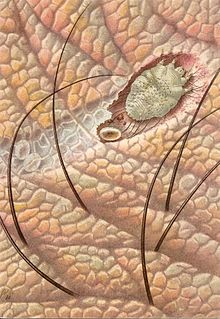Grave mites
| Grave mites | ||||||||||||
|---|---|---|---|---|---|---|---|---|---|---|---|---|

Scabies mite ( Sarcoptes scabiei ) |
||||||||||||
| Systematics | ||||||||||||
|
||||||||||||
| Scientific name | ||||||||||||
| Sarcoptes | ||||||||||||
| Latreille , 1802 |
The grave mites or scabies mites ( Sarcoptes from sarx 'meat' and koptein 'bite, wound') are a genus of mites . They live as parasites in the skin of mammals , where they create holes in the epidermis , in which the eggs are laid. The sarcoptic mange caused by grave mites, often just mites for short , is known as " scabies " in humans and is characterized by severe itching and crust formation. The grave mites generally have a relative host specificity, but the grave mites of the animals can also pass over to humans (“pseudo-scabies”).
morphology
Female grave mites are approximately 0.3 to 0.5 mm long and 0.225 to 0.4 mm wide. The turtle-like body is oval, flattened on the belly and arched on the back. The surface of the body has strong thorns and scales of skin with obliquely furrowed cuticular grooves. Grave mites have a wide, rounded capitulum . Of the short legs, only the first pair of legs protrudes over the edge of the body. The front three pairs of legs have a long, non-articulated sticky handle with a terminal sticky plate. The rear pair of legs has a terminal bristle.
The male adult mites are smaller (0.205-0.285 mm long and 0.145-0.210 mm wide). In males, the fourth pair of legs also has a long sticky handle with a small sticky disc.
Development cycle
The males live on the surface of the skin or in shallow tunnels. This is where copulation takes place, after which they die. Female grave mites dig into the stratum spinosum or granulosum of the epidermis with their mouthparts ( chelicerae ) and live there for about three to six weeks. During their lifetime they lay about fifty 0.16-0.19 × 0.084-0.103 mm eggs in the holes they created. The development cycle of grave mites lasts between 12 and 21 days and shows three stages of development.
The larvae hatch from the eggs after 3 to 5 days . They are about 0.14-0.21 mm long and 0.1-0.16 mm wide, have only three pairs of legs and live mainly in the bores.
The larvae molt into their own skin niches nymphs , which morphologically resemble the adult females, but are much smaller and not yet sexually differentiated. The initially emerging protonymphs are 0.18–0.3 mm long and 0.13–0.25 mm wide. After about three days, they develop into 0.18-0.3 × 0.16-0.27 mm Tritonymphen . These molt into adult grave mites after a further 3 to 4 days.
Systematics
In the specialist literature, there are two different views on the systematics of grave mites. The individual representatives are practically indistinguishable morphologically and have only a limited host specificity: Under favorable conditions they can also be transferred to other hosts , but then only cause a temporary disease. Therefore, depending on the author, the individual representatives are either summarized as one type or divided into several types.
For one, it will all grave mites only one type - Sarcoptes scabiei - assigned and these assigned depending on the host to a corresponding sub-species (eg. Sarcoptes scabiei var. Hominis - grave mite human; Sarcoptes scabiei var. Canis - grave mite of the dog and pathogens the sarcoptes mange of the dog ; Sarcoptes scabiei var. cati - grave mite of the cat).
According to the other opinion, the representatives are considered to be independent species, e.g. B. Sarcoptes scabiei - grave mite of humans, Sarcoptes canis - grave mite of the dog, Sarcoptes equi - grave mite of the horse , etc.
history
Sarcoptes as the cause of scabies was discovered by Giovanni Cosimo Bonomo (1663-1696) in 1687 (with the pharmacist Diacinto Cestoni) and communicated in a letter to Francesco Redi (1626-1697). They observed an egg laying and suspected that the scabies is transmitted through clothing. The personal physician of Pope Giovanni Maria Lancisi contradicted parasites as the sole cause and Bonomo avoided a dispute with him. Bonomo's observation was also the first evidence of an infectious disease caused by parasites and generally microscopic living things.
See also
literature
- Ekkehard Wiesner and Regine Ribbeck: Dictionary of veterinary medicine . Enke, 3rd edition, 1991 ISBN 3-432-28121-8
- Sigrun Lerch: Investigation of the antigenic protein fractions of a sarcoptic mite extract by SDS-PAGE, immunoblot, two-dimensional gel electrophoresis and sequence analysis . Dissertation FU Berlin 2002 ( online )
Individual evidence
- ↑ Georg von Samson-Himmelstjerna, Horst Zahner, Johannes Eckert, Peter Deplazes: Textbook of Parasitology for Veterinary Medicine. 2012, ISBN 3-8304-1205-3 , p. 424.
- ^ Clifford Pickover, The Medical Book, Sterling Publ. 2012

